Laptop Mag Verdict
The Yoga Tablet 2 combines a handy kickstand with very long battery life, making it one of the better Android tablet values.
Pros
- +
Really, really long battery life
- +
Versatile multi-mode design
- +
Loud speakers
- +
Useful quick-settings menu
Cons
- -
Relatively heavy
- -
Limited MultiWindow mode
Why you can trust Laptop Mag
In a sea of me-too Android tablets, the Lenovo Yoga Tablet 2 has no problem standing out -- literally. Like its predecessor, this 10-inch Android slate ($269) has a built-in kickstand that allows you to use the tablet in multiple modes. And the unique cylindrical part of the slate's design continues to house a mammoth battery. This sequel adds a bunch of upgrades, too, including a faster Intel processor and larger front-facing speakers. Although it's on the heavy side, the Tablet 2 offers a lot for its low price.
Design
I give credit to Lenovo for addressing the unnecessarily tight hinge on the original Yoga Tablet. This time around, the metal kickstand is easier to open, if not quite seamless.
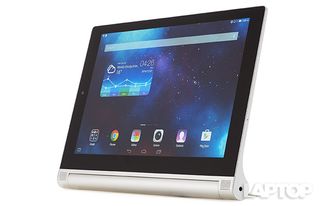
You just need to apply a bit of pressure to the hinge to get the stand to pop up, then glide the stand into the desired position. (See Multiple Modes below for more detail).
The rest of this silver slate is made of plastic, but the overall design felt solid. The back panel has a pleasant finish of raised dots.

When positioned in landscape mode, the Yoga Tablet 2 houses the power button on the left side of the cylinder, and the right side has a headphone jack. A microUSB port and a volume rocker line the left side above the cylinder.

Open the kickstand, and you'll find a door underneath that pops out to reveal microSD card and SIM Card slots.
The Yoga Tablet 2's versatility comes at a price -- it's a heavyweight. Coming in a 1.36 pounds, this slate is significantly heftier than the 0.96-pound iPad Air 2 and 1.25-pound Asus Transformer Pad TF103C.

Yes, being able to hold the device by its cylindrical bulge helps in terms of comfort, but even in this mode, the Tablet 2's weight started to strain my wrist after a few minutes.
Multiple Modes
The Yoga Tablet 2 offers four modes of operation: stand, tilt, hold and the new hang.
Stand is pretty self-explanatory, as you can stand the tablet upright on a table, desk or counter in landscape mode, ideal for watching a flick or working on a recipe.

Tilt mode means you position the stand so that it faces downward, propping the screen up at an angle. This mode came in handy for typing; I call it laptop mode.
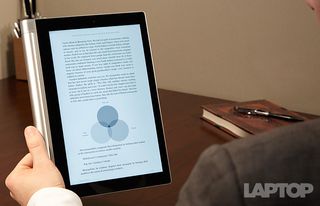
Hold simply means holding the Yoga Tablet 2 in portrait mode with your hand on the cylindrical portion of the device.

Hang mode refers to using the cutout in the kickstand for hanging it anywhere there's a hook. This could be in the kitchen, gym or car (with the right accessory).
While you may still want to invest in a case for the Yoga Tablet 2 to protect its display while in transit, the built-in kickstand means you get more modes than a $39 iPad Smart Cover, without having to spring for an extra accessory.
Display
The Yoga Tablet 2's 1920 x 1200-pixel display is brighter than the previous Yoga 10 HD+, but it still doesn't offer the richest color palette. When I watched the Star Wars VII: The Force Awakens Trailer, the screen delivered a fine level of detail, from the sweat on John Boyega's face to the scuff marks on his Storm Trooper uniform. However, the sand and sky looked paler on this panel versus on my iPhone 6.

According to our colorimeter, this slate can display 68.4 percent of the sRGB color gamut. That's a far cry from premium tablets such as the iPad Air 2 (99.6 percent) and the category average (83 percent), but in the same ballpark as other budget devices, such as the LG G Pad 10.1 (63.9 percent) and Asus Transformer Pad TF103C (59.4 percent).
The Yoga Tablet 2 doesn't offer great color accuracy either, as its display registered a Delta-E score of 9.4 (closer to 0 is best). That's worse than the category average (5.6) and the G Pad 10.1 (1.5), but at least it beats the TG103C (10.5).
Lenovo's tablet beats most of the value-priced competition on brightness. The screen averaged 374 nits, which is higher than the previous Yoga 10 HD+ (339 nits), the category average (336 nits) and the G Pad and Transformer Pad.
Audio
Thanks to its front-facing stereo speakers, the Yoga Tablet 2 is one boisterous tablet. Even with the volume at 75 percent, the slate filled my office with sound when streaming Alex Care's "Too Close." I would just stay away from max volume, as the audio becomes too tinny.
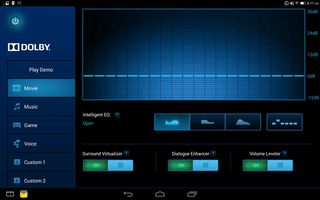
To help you customize the sound to your liking, Lenovo bundles a Dolby app that includes different modes, equalizer presets and various effects. For listening to tunes, I found that engaging the Rich Intelligent EQ and Surround Virtualizer settings delivered the best results.
On the Laptop Mag Audio Test, the Yoga Tablet 2 hit 90 decibels, which is a lot higher than the 79 dB average.
Interface
Although it runs Android 4.4 KitKat, Lenovo has modified Google's OS in a few significant ways. For example, swiping up from the bottom of the screen reveals a custom quick-settings menu called Bottom Switch. (It's very reminiscent of iOS.) Swiping down from the top of the screen shows the Notifications menu.
In the Bottom Switch menu, you can toggle everything from Wi-Fi and Bluetooth to Dolby audio effects and Multi Window mode. You can also adjust the screen brightness from this menu, take a screen shot, fire up the camera and more.
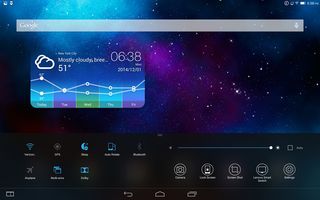
The most interesting Bottom Switch option is Lenovo Smart Switch, which enables the Yoga Tablet 2 to automatically change display and Dolby audio profiles as you switch from one mode to the next. For instance, entering Hold mode (holding the tablet by the cylinder portion) can trigger a matte display setting that's optimized for reading. You can also customize what happens yourself.
I like that Lenovo doesn't offer an apps menu separate from the home screen area. You just swipe from left to right to see your apps.
MultiWindow
The MultiWindow functionality on the Yoga Tablet 2 is so limited, it's almost not worth it.
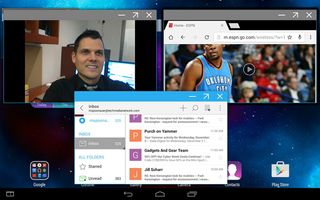
Yes, it's nice that you can run up to three apps on the screen and one in a floating window -- or two in split-screen mode -- but MultiWindow works with only six apps. These include Email, Gallery, Chrome, File Browser, Calculator and Video (player).
I would have liked to see Gmail and YouTube added to the list, as well as Facebook and Twitter. What I do like is that that apps you've opened in MultiWindow mode show up at the bottom of the screen when minimized, just like icons on the Windows taskbar.
Apps
Lenovo loads the Yoga Tablet 2 with a mix of bloatware and useful apps. The apps I'd use include KingSoft Office, Kindle and perhaps Lenovo eFrame for showing off photos in Stand mode. I'd delete the pointless Gamestore (use Google Play) and Route 66 Navi (use Google Maps).
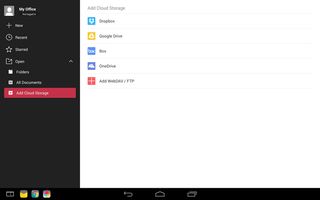
Among Lenovo's own apps, ShareIt is the most compelling, provided the other person has the same app installed. With this tool you can share large files via Wi-Fi direct. SyncitHD backs up contacts, which you don't need, and Cloneit copies apps, contacts and system settings to a new device.
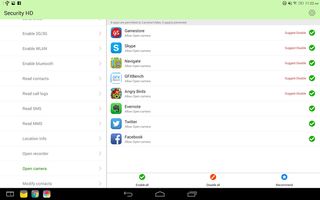
The Security HD app is a misnomer. It doesn't offer any antivirus protection, but it can help block ads within apps and can give you suggestions on what permissions to allow or not. The app also promises to speed up the Yoga Tablet 2 by closing unused apps.
My biggest problem with Android tablets continues to be that many apps (like Facebook, Pandora and Yelp) are still merely stretched-out versions of their phone counterparts. Developers need to optimize their wares for larger displays.
Performance
The Yoga Tablet 2 swaps the Snapdragon 400 processor inside the Yoga Tablet 10 HD+ for Intel's 1.86-GHz Intel Atom Z3745 CPU with 2GB of memory. The tablet provided smooth performance in the frenetic Bruce Lee game; even with multiple bad guys on the screen at once, the Yoga Tablet 2 kept pace with my quick finger-swipes. I also appreciated that I could quickly switch apps and scroll in Chrome without lag. However, switching screen orientations took longer than I'd like (nearly 1.5 seconds).

On Geekbench 3, which measures overall performance, the Yoga Tablet 2 scored 2,396, similar to the Asus Transformer Pad TF103C (2,376) and the category average (2,375). The cheaper LG G Pad 10.1 (1.2-GHz ARM A7) mustered only 1,150. Similarly, the Yoga took about the same amount of time as the Transformer Pad to transcode a 1080p video, 5:28 versus 5:22. The tablet average is about 9 minutes.
The Yoga Tablet 2 finished slightly ahead of the Transformer Pad on the 3DMark Ice Storm Unlimited graphics test, notching 15,055 to the Asus' 14,569. The Lenovo even beat the Galaxy Tab S 10.5 (13,481).
Cameras
Don't expect any masterpieces from the Yoga Tablet 2's back 8-megapixel camera.
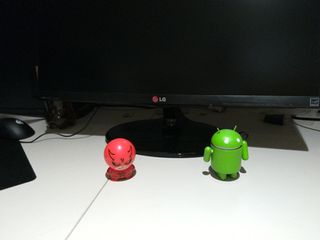
A shot of a couple tchotchkes looked grainy, and a red character came across as more pink. A selfie shot with the front 1.6-MP camera captured the sheen in my striped tie, but the overall photo looked blurry.
I tested the 1080p camcorder by shooting some footage of traffic, and the Yoga Tablet 2 struggled a bit with focusing on moving cars. When the camera did lock on, I could easily make out the many cracks in the road.
On the plus side, the Yoga Tablet 2 includes a surprising amount of camera settings and effects for a tablet. You'll find a handful of scene modes (from Portrait to Sports); a few color effects, including Mono, Sepia and Negative; and myriad other settings for tweaking exposure, brightness, contrast and more.
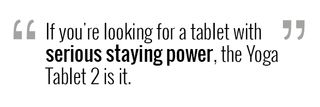
Lenovo Yoga Tablet 2 Specs
| Brand | Lenovo |
| CPU | Intel Atom Z3745 |
| Camera Resolution | 8MP |
| Company Website | http://www.lenovo.com |
| Display Resolution | 2560 x 1440 |
| Display Size | 13.3 |
| Front-Facing Camera Resolution | 1.6MP |
| OS | Android 4.4.2 |
| Ports | microSD, 3.5mm audio jack, microUSB |
| RAM Included | 2GB |
| Storage Drive Size | 32GB |
| Storage Drive Type | Flash Memory |
| Weight | 2.1 pounds |
| Wi-Fi | 802.11ac/a/b/g/n |

